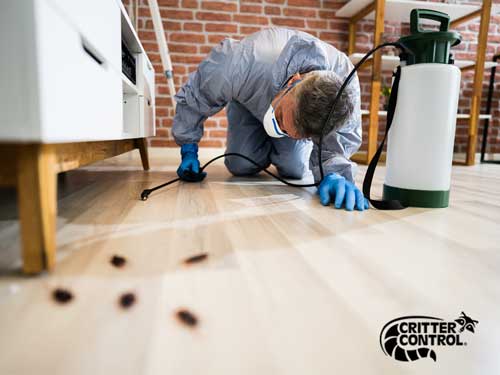Bed Bug Therapy Breakdown: Contrasting Chemical Vs. Non-Chemical Solutions
In the realm of insect control, especially when handling the consistent issue of bed insects, the selection in between chemical and non-chemical treatment solutions can be a crucial one. Both strategies supply distinct advantages and drawbacks, influencing factors such as performance, safety considerations, and total price. By taking a look at the nuanced details of each approach, a clearer understanding of which path to go after in dealing with a bed insect invasion can be acquired.
Efficiency of Chemical Treatments
Chemical treatments for bed bug invasions have actually been widely recognized for their potent and fast efficiency in getting rid of these insects. When thinking about the efficiency of chemical therapies, it is essential to recognize that they can provide a quick and detailed solution to a bed bug problem.
Furthermore, chemical treatments have the advantage of providing recurring impacts, suggesting that they can remain to remove bed bugs also after the first application. This residual action is specifically beneficial in combating any type of prospective re-infestations. In addition, the rapid action of chemical treatments can bring alleviation to people facing extreme bed bug invasions, allowing them to regain control of their living areas promptly.
Safety Worry About Chemical Solutions
When using chemical options for bed insect therapy is ensuring the safety of owners and the setting,One vital aspect that needs mindful consideration. While chemical therapies can be effective in removing bed bugs, they may pose risks if not managed properly. One of the key safety and security issues with chemical services is the prospective injury they can trigger to human health. Exposure to particular chemicals used in bed pest treatments can cause respiratory system problems, skin irritation, or various other damaging responses, specifically in individuals with pre-existing conditions or sensitivities. Furthermore, incorrect application or dosage of chemical pesticides can result in poisonous deposits remaining in the treated area, posing lasting health risks to passengers.
Furthermore, the ecological influence of chemical solutions is one more considerable consideration. Some pesticides made use of in bed insect treatments might be unsafe to advantageous bugs, wild animals, and ecosystems if they seep into the soil or water systems. It is important to utilize chemical therapies judiciously, following safety guidelines, and taking into consideration less hazardous options to reduce these dangers and make sure the reliable and safe administration right here of bed bug infestations.
Advantages of Non-Chemical Methods
Considering the prospective safety and security problems and ecological effect connected with chemical services for bed insect treatment, exploring non-chemical methods presents an encouraging option with a number of distinctive benefits. Non-chemical treatments are environmentally pleasant, as they do not contribute to air or water pollution, making them a sustainable choice for bug control.
Furthermore, non-chemical options can be effective in targeting bed pests, consisting of hard-to-reach areas where chemical treatments may not penetrate. Methods such as heat therapy, vacuuming, vapor cleaning, and bed mattress coverings provide detailed removal without making use of damaging chemicals. In addition, non-chemical methods can be less turbulent, needing very little prep work and enabling quicker reentry right into dealt with areas. Generally, going with non-chemical bed bug treatment techniques not only prioritizes safety and environmental management however likewise ensures detailed and effective pest control.
Limitations of Non-Chemical Treatments

In addition, non-chemical website here therapies commonly call for multiple applications to accomplish effective obliteration. This can be lengthy and might not constantly ensure full elimination of all bed bugs and their eggs, especially in hard-to-reach or surprise places.
Moreover, the success of non-chemical treatments heavily relies on appropriate application and thoroughness, which can be challenging for individuals without expert knowledge. Inadequate application of non-chemical techniques might cause insufficient eradication, leading to persistent problems and the requirement for added treatments.
As a result, while non-chemical treatments have their benefits, it is necessary to acknowledge these restrictions and consider them when identifying one of the most reliable approach for managing bed insect problems.
Price Comparison: Chemical Vs. Non-Chemical Options
Provided the constraints connected with non-chemical treatments, a necessary facet to assess in the context of bed pest monitoring is the cost contrast between chemical and non-chemical options. In contrast, non-chemical therapies like warmth therapy or vapor can be more costly, with expenses varying from $1,000 to $6,000 for an entire home. While the preliminary cost of chemical therapies may appear lower, several treatments might be called for to fully eliminate the infestation, possibly boosting the general price.
Verdict

Considering the potential security issues and ecological influence linked with chemical remedies for bed pest therapy, checking out non-chemical methods provides an appealing option with numerous distinctive benefits.Offered the restrictions associated with non-chemical therapies, an important facet to assess in the context of right here bed insect monitoring is the expense contrast in between chemical and non-chemical options. In comparison, non-chemical treatments like warmth therapy or steam can be a lot more expensive, with expenses varying from $1,000 to $6,000 for an entire home. While the initial price of chemical treatments might appear reduced, multiple treatments might be called for to completely eliminate the invasion, possibly enhancing the total cost.In final thought, when contrasting chemical and non-chemical bed insect therapy alternatives, it is crucial to take into consideration effectiveness, security, benefits, constraints, and cost.